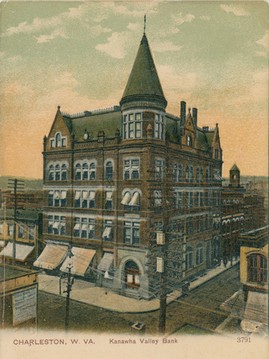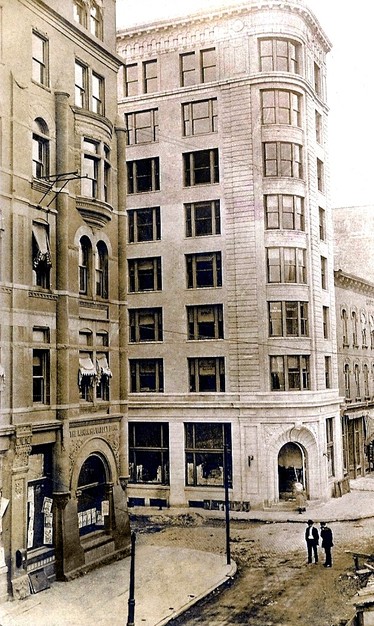Kanawha Valley Building
Introduction
Text-to-speech Audio
Images
The Kanawha Valley Building

The second structure that housed the Kanawha Valley Bank along Kanawha Boulevard.

A side view of the Kanawha Boulevard location that was lost to urban renewal. The Terminal Building still exists today.

Backstory and Context
Text-to-speech Audio
The Kanawha Valley Bank was established in 1867 by William Dickinson, Levi Woodyard, Henry Dickinson, and John Q. Dickinson. The Dickinson family was deeply associated with the beginning of the salt industry in Charleston, WV, and founded a bank to accommodate early industries in West Virginia. The original bank building was two stories high and located at the intersection of Kanawha Boulevard and Capitol Street for 26 years. Henry Dickinson became the mayor of Charleston in 1870, as well as the bank president, however he passed away in 1871. The presidential position stayed in the Dickinson family and was passed down to John Q. Dickinson in 1872, and remained in his power for the next 43 years.
“The head of this bank is Col. John Q. Dickinson, of this city, who is widely recognized as one of the leading bankers of the country. His dealings are multitudinous; his methods are modern and he is in every way the type of business man who merits success.”1
Shortly after John Q. Dickinson’s appointment, the financial panic of 1873 occurred; the Kanawha Valley Bank was the only bank opened in Charleston after the Civil War to survive.
In 1893, the original Kanawha Valley Bank building was demolished and replaced with a new five story building. The new bank building was a power move by John Q. Dickinson to better accommodate the growing industries in West Virginia. John Q. Dickinson’s son, John L., was the cashier of Kanawha Valley Bank from 1894 until 1925 when he replaced his father as the president of the bank.
In the late 1920s, John L. Dickinson decided to build a new Kanawha Valley Bank building on a historic piece of Charleston land. The plot of land was purchased by the State of West Virginia in 1868, and housed the West Virginia State Capitol from 1885 to 1921. After the capitol burned down in 1921, the property was split into 19 sections. The Kanawha Valley Bank purchased to corner portion and hired architects Alfred C. Bossom and Charles A. Haviland to design the new bank building. The Kanawha Valley Bank building was completed in 1929, just a year before the stock market crashed. The Kanawha Valley Building is the second tallest building in the state of West Virginia, following the West Virginia State Capitol, and matched by Laidley Tower.
The Kanawha Valley Bank building along Kanawha Boulevard was lost to urban renewal, and is now the location of a plaza belonging to Chase Tower. Hugh Curry became the president of Kanawha Valley Bank in the late 1960s, and is responsible for modernizing banking in West Virginia by creating branch banking. Curry worked in conjunction with Robert F. Baronner, who created One Valley Square, where the Kanawha Valley Bank moved to and merged with in 1976. One Valley Bank was bought out by BB&T in 2000. Today the Kanawha Valley Building is utilized as commercial real estate and office space.
Cite This Entry
Hailey Horn on behalf of Preservation Alliance of West Virginia. "Kanawha Valley Building." Clio: Your Guide to History. March 21, 2017. Accessed April 28, 2025. https://theclio.com/tour/1596/93
Sources
Snyder, R. N.. Illustrated and Descriptive Charleston, WVa. Charleston, WV. News-Mail Company, 191?.
Marshall, Paul D.. Cook, John D.. Historical and Architectural Survey Downtown Charleston, West Virginia. Charleston, WV. Charleston Regional Chamber of Commerce, 1984.

